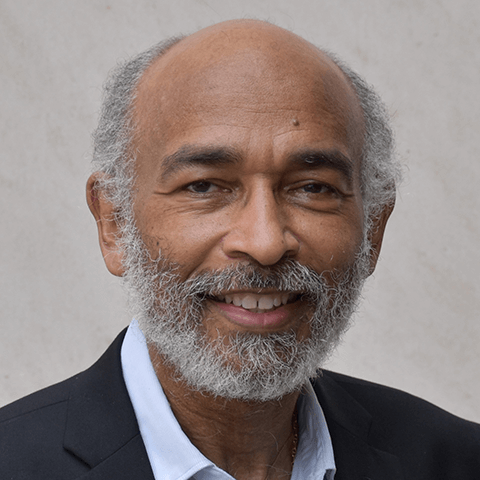Emery N. Brown, M.D., Ph.D.
Honorary Degree Recipient, 2025 Commencement Howard University
Emery N. Brown, M.D., Ph.D. is the Edward Hood Taplin Professor of Medical Engineering, a professor of health sciences and technology, and a professor of computational neuroscience at the Massachusetts Institute of Technology. He is also the Warren M. Zapol Professor of Anaesthesia at Harvard Medical School and an anesthesiologist at Massachusetts General Hospital (MGH).
Professor Brown was born and grew up in Ocala, Florida, along with his two older siblings Benjamin and Stephen. His parents, Benjamin and Alberta Brown, were high school mathematics teachers. Through sixth grade, he attended the segregated Fessenden Elementary School. Brown graduated high school from the Phillips Exeter Academy in Exeter, New Hampshire, where he spent the second semester of his senior year studying Spanish in the School Year Abroad Program in Barcelona, Spain.
Brown received his B.A. in applied mathematics (magna cum laude) from Harvard College. He next studied mathematics for a year as an International Rotary Fellow at the Fourier Institute in Grenoble, France. After returning from France, Brown obtained his M.A. and Ph.D. in statistics from Harvard University and his M.D. (magna cum laude) from Harvard Medical School. Brown completed his internal medicine internship at the Brigham and Women’s Hospital, his anesthesiology residency at MGH, and thereafter joined the MGH Department of Anesthesia.
At the outset of his career, Brown focused his research on statistical methods to characterize the properties of the human circadian (biological) clock. Most notably, he derived an analytic formula to accurately measure the error in the period of the human circadian clock estimated from core temperature measurements recorded during a forced desynchrony protocol. Brown’s error analysis was critical for demonstrating that the intrinsic period of the human circadian clock was, like that of other species, closer to 24 rather than 25 hours. He also developed a statistical model to analyze how light shifts the phase of the human circadian clock depending on when during the circadian cycle the light is administered. Brown later used his statistical skills to measure the efficacy of shift work schedules designed using circadian physiology.
In the second phase of his career, Brown developed statistical techniques and signal processing methods to analyze data collected in neuroscience experiments. He introduced state-space methods for point processes, the analog of the Kalman filter used in engineering for continuous-valued measurements. He used the methods to “read a rat’s mind,” i.e., precisely locate a rat’s position in space by decoding the neural activity in the animal’s hippocampus (short-term memory center). Brown later used the methods to characterize neural and behavioral activity in learning experiments; define loss and recovery of consciousness in human anesthesia studies; and implement a closed loop system for controlling a medically-induced coma in a rodent model.
For the last 20 years, Brown has focused his research on understanding the neurophysiology of general anesthesia. His work has revealed that general anesthesia is not sleep but rather a pharmacologically-mediated, reversible coma. Indeed, a patient must be in a coma to tolerate the trauma of surgery. Brown’s research has shown that during anesthesia, the brain is not turned off. Rather, the anesthetic agents produce highly structured (typically low frequency), high amplitude, oscillatory brain waves that disrupt communication among brain regions. These oscillations change systematically with anesthetic dose, anesthetic class, patient age and patient state of health. Brown has shown that electroencephalogram-based brain monitoring can be used to track these oscillations in real time and guide anesthetic dosing during surgery. He has demonstrated that these oscillations can be used as control signals for automated, closed loop anesthesia administration.
Brown’s research has been featured in the New York Times, Scientific American, MIT Technology Review, TED MED and on National Public Radio.
Brown served on President Barack Obama’s Brain Initiative Working Group. He currently serves on the Boards of Trustees of the Simons Foundation and the Guggenheim Foundation, the board of directors of Humacyte, the editorial board of the New England Journal of Medicine, and the Scientific Advisory Board of the Neuroscience Program for the Tatiana Foundation.
Brown’s accomplishments have been widely recognized. He is a fellow of IEEE, the American Association for the Advancement of Science, the American Academy of Arts and Sciences, and the National Academy of Inventors. He is also a member of the American Philosophical Society. Brown is the first African American elected to all three national academies: medicine, sciences, and engineering.
Brown has received a National Institutes of Health Director’s Pioneer Award, a Guggenheim Fellowship in Applied Mathematics, the American Society of Anesthesiologists Excellence in Research Award, the Swartz Prize for Theoretical and Computational Neuroscience, the Pierre Galletti Prize, the Gruber Prize in Neuroscience, and Doctor of Science Honoris Causa degrees from the University of Southern California and the State University of New York Downstate. At a White House ceremony on Jan. 3, Brown received the 2024 National Medal of Science.

